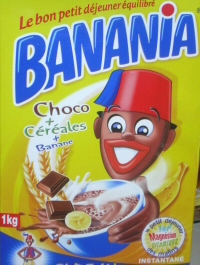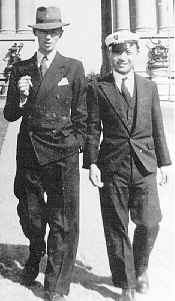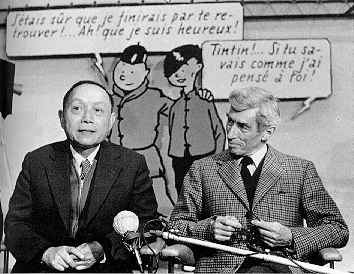
After three installments criticising Hergé for rampant racism and xenophobia, I uneasily picture his ghost appearing before me, with a quizzical smile.

« So, » says the ghost, « you’ve really dragged me through the mud, eh ? But what about yourself, Alex? Are you a racist?”
“No!” I answer. ”No, but…”
New York, Washington Square Park. I loiter around a chess game – I’m a rotten player, but I enjoy it as a spectator sport. Somebody grabs my arm—a muscular young Black man. I tense up with a fight-or-flight boost of adrenaline…
“You want a game?” he asks.
He didn’t want to mug me, he wanted to play chess.
Many another middle-class, middle-aged White man can attest to such embarrassing moments, where — despite professed liberalism– racist instincts seem to kick in at the worst times. It’s good that our conscious selves master our subconscious. The fact is, for one of my generation (I was born in 1954), urban African-Americans were synonymous with danger; an unofficial apartheid divided the city; and despite the fact that I was never hurt or even threatened by a Black man (the few times I was mugged were by Whites), I had internalised this detestable racist prejudice, one that went unspoken
Yet, would I have reacted the same had the incident occurred in Paris? I doubt it.
I was born to a French father and an American mother, growing up bi-cultural in America with long stays in France, where I now live. Like many bi-culturals, I have something of a split personality: there’s an American Alex and a French Alex.
French Alex has no doubt internalised quite different prejudices towards Black people. Consider this poster for a chocolate drink known to all French kids:

That soldier is a Tirailleur Sénégalais, one of hundreds of thousands of colonial soldiers sent to the front in World War One. Note his joyful laugh, over his exclamation “Y’a bon!”, which can roughly be translated as “Sho’nuff good!” The slogan is still heard as a racist taunt.
This was the French cliché of the Black man: a merry, childlike creature eager to serve his master. And I wonder if somewhere deep in my subconscious, that stereotype shamefully thrives.
(The image itself is still used:)

This is the context in which we should consider Tintin au Congo, and Hergé’s various racist lapses: they won’t in themselves convert a kid to racism, but they will confirm the mentally and morally lazy stereotypes that pervade every culture. And it’s hard to underestimate the ubiquity of Tintin in Europe. So, the librarians who remove Tintin au Congo to the adult stacks are doing their duty.

Myself, I got a bit of a jolt reading Tintin en Amérique. Even as an eight-year-old, I knew this America was just a comic fantasy:

…and no American I knew was remotely like the greed-crazed, thuggish citizens depicted therein.

I was, for once, at the sharp end of Hergés stick.
So, Tintin to the incinerator?
No. Other powerful and positive forces of Hergé’s approach to the Other are the attraction and wonder of foreign lands, foreign people. How many youths have set out to explore the world inspired by Tintin? And aren’t the values embodied by the plucky little reporter worthwhile ones—courage, loyalty, justice?
Besides which, the Tintin albums are simply wonderful yarns, crammed with suspense, comedy that is often uproarious, lovely art. They are about as fun as comics can get.
As for Chang, the young student who opened Hergé’s eyes to Chinese civilisation, he returned to Shanghai in 1936 to open a drawing school, which he managed for thirty years. He was purged by the Cultural Revolution, in which he suffered badly. Hergé never stopped trying to help him, and finally was able to bring him back to Belgium in 1981. The two friends were speechless at their reunion, 44 years after their separation.

Herge and Chang in 1931…

…Chang and Herge in 1981.
Let’s conclude where we started four chapters ago : with Tintin au Congo.
How do Africans feel about it?
It is, in fact, a perennial seller in Francophone Africa. Hergé was delighted that it was serialised in 1969 in the prestigious African Zaïre magazine.
That may sound like another depressing example of internalising one’s oppression…but not so fast. Here’s what Zaïre had to say about the strip:
“If certain caricatures of the Congolese people in Tintin au Congo make White people laugh, they also made the Congolese readers laugh because they found plenty to mock in the White man who saw them that way!”
In other words, they are laughing at, not with, the whites.
Three examples of African appropriation of Hergé’s imagery:

Sculpture from Kinshasha, Zaire

Kinshasha street mural
From Benin: Tintin, Congolese, and a missionary.
All Tintin art and images copyright Moulinsart
The entire Tintin in Otherland series is here.


The discussion of the reaction to Tintin in Zaire is fascinating. I wonder if there’s the same debate about whether to make it readily available to kids there? And also whether the “laughing at the perpetrator” has in the past extended to other blackface iconography, or if Tintin (by virtue of popularity? history?) is a special case….
Well, the student who sued to have Tintin banned in Belgium is Congolese…but an African living abroad might be more sensitive to such racism, however naive, than Africans in their native country, the former being frequent targets of racism, the latter feeling secure.
I guess the Congolese see it as high camp!
I knew French Black men who deliberately adopted ‘Y’a bon, Banania!’ as a derisive cry.
BTW, Noah, if you want a good example of co-opting the enemy’s attack…consider the American adoption of ‘Yankee Doodle’, which was originally a satirical anti-American British song!
That wooden toy is beautiful.
Tragically, I think the Congolese have a lot worse things to think about than Tintin at the moment.The country appears to be regressing due to the impact of many years of civil war.
One thing I wonder. Alex, you mentioned earlier in your articles that the Congo was run by Leopold II in a particularly evil and merciless way, and I would definitely agree with that. However, many in the civilised world were aware of this through Joseph Conrad’s work, Heart of Darkness.
I wonder to what extent the Tintin book is a response to Conrad’s ? Conrad presents the Congo as a place of barbarity in which to linger is to invite madness and a loss of humanity, hardly attractive to any likely Belgian would-be colonial officer. Herge presents the Congo as someplace where one can have adventure, excitement and really wild fun – sign up now, kids !
Note also that both works turn around the idea that the white man is worshipped as a god by the natives – but ” The Horror” for Tintin is non-existant, it would seem.
I bet it matters that Herge is Belgian and Conrad was not….
@dave Moran:
Hi, Dave.
I doubt very much that Hergé even knew about Conrad’s novel. At the time, he lived in a very strict cultural bubble of reactionary Catholicism; and, anyway,we mustn’t over-estimate the impact of that fine novella on public opinion even in the Anglophone world (I suspect Vachel Lindsay’s sensationalist poem ‘The Congo’ had more influence.)
What is undeniable is that, in the hideous annals of colonial oppression, Leopold II’s Congo Free State holds a special record for horror. There was nothing like it until the Nazi Holocaust. In fact, the term ‘crime against humanity’ was first used against Leopold.
The international outcry was such that Leopold signed over the Congo (theretofore his private property) to Belgium. Conditions improved…relatively.
I think Hergé was not so much propagandising for the Belgian Empire as such, as he was for Catholic missionary efforts in the land.
Interesting that the villains in Tintin in the Congo were American gangsters, emissaries of Al Capone. This might reflect the growing international influence of the USA in the ’20s and ’30s, which alarmed many in old Europe…by George, which still alarms them!
I recommend one look up ‘Leopold II’ and ‘Congo Free State’ on Wikipedia for a horrific snapshot.
As for ‘Tintin au Congo’ lingering successfully on in Francophone Africa, I wonder how much this is due to simple inertia?
Just wanted to give a heads up; we have a troll on this thread throwing up various sock puppets. I think we’ve basically got it under control, and I’ll delete him when I see him, but just be aware, do not feed, etc.
Thanks all.
Pingback: [LinksRoundUp] Big like a pickle : Black Comix
Tintin was to some extent a window on to the adult world. his steady friends and enemies are all much older and he is a transitional figure, the boy reporter who nevertheless lives on his own (with Milou and occasionally, with Haddock.)
Apart from being brave, defender of the weak, he has no features, even physical, apart fm his coiffe. his friends are pretty weird, though. They are also Other: alcoholic sailor Haddock, nerd Tournesol, misfit cops Dupondts. Nestor is normal. The most normal charcter is Milou, if you forget he’s a human dog.
Whole experience was discovering the world through all the people and places he encounters, that was a big part of the excitement.
I’m super-late getting around to reading this series, as usual, but I wanted to chime in and say that it’s some great, fascinating reading, sure to provide much-needed context the next time I read any Tintin. Thanks, Alex!
And thank you, Matthew, for your kind remarks!
Dear Alex Buchet====Even though my both parents were, but because i was born in Beirut/LEBANON 1947, i too had semi split personality .. l;et s call it ArmenioArab ??
At school / home , i was an Armenian, but with Arab neighbors.. got to act as if an Arab boy .
If my parents then chose to live in the Armenian quarter of the city ,, there was no such NEED, because everything in BOURJ HAMMOUD area was in Armenian ,spoken & written ,like shop signs,even the restaurants Menu s! And even though we came to Lebanon for shelter and as refugees in late 1917 s Aftermath the infamous Armenian Genocide 3 years prior to that date ,but over that quarter Armenian language came 1.st followed by country s Arabic. that s why Armenians conversing in proper Arabic ..was rare ,even
Scarce., maybe now days things are much better and improved,as i am 35 years away from the whole thing, Well sorry i am not here to tell Our History, but what i am about is we had and still having fine treatment in LEBANON , that s why our hearts always goes to that FIRST Democratic Nation even befrd the creation of the Jewish nation by 1948?..French /English languages were handy and a robust pathway for success in Uni.Studies and careers wise, //// Now about the Black people ., the only few dark skinned people we ever knew were the African Embassies staff.. even during my childhood period there were only few Independent African countries then?? and most popular black individuals were the ARAB SUDANESE / monkey nuts /pistachio street corners vendors, very humble modest people ..too,and very kind friendly as well, they lived very poorly on empty buildings Roof tops in downtown Beirut area, It was Only then, when HOLLYWOOD movies inserted AfroAmerican actors such as Legends as SYDNEY POITIER..HARRY BELAFONTE..NAT king COLE ..followed by CASSIUS CLAY s victories & converting to ISLAM as (Mohamed Ali) , made us all Arabs/Armenians/Kurds/Jews/Druz in the Lebanon especially , and around generally to believe that people shouldn t be judged by their skin Colors or Beliefs, but by what they contribute to society/(ies)??////To this day i still feel very sorry for that LITTLE Black cute boy, lived in our neighborhood in the 1960 S , just because his Dad was dark skinned PERSON !!..Boy & Mother , returned from Saudi Arabia where she met the boys father, so all,the so called street wise guys persecuted/harassed that little boy ..calling him names and also the Arabic version of that shameful expression N….?? ///Also i blame the Egyptian Arab cinema those days for using Sudanese characters as WAITERS/SERVANTS inferior to the Egyptian individuals,,never a very dark skinned actor appeared as a leading film hero,even though Egypt is in the BLACK Continent, itself?? which reminded me Tom & Jerry cartoons ,where the only human character was 2 BLACK LEGGED( only what we used to see of her )?)of a HOUSEMAID? ? Thank GOD all that …CHANGED! and we , the fair or >>> WEE BIT dark skinners , guys N dolls,,, got CIVILIZED!!!
Dear Alex Buchet====Even though my both parents were Armenians . but because i was born in Beirut/LEBANON 1947, i too had semi split personality .. l et s call it ArmenioArab ??
At school / home , i was an Armenian, but with Arab neighbors.. got to act as if an Arab boy .
If my parents then chose to live in the Armenian quarter of the city ,, there was no such NEED, because everything in BOURJ HAMMOUD area was in Armenian ,spoken & written ,like shop signs,even the restaurants Menu s! And even though we came to Lebanon for shelter and as refugees in late 1917 s Aftermath the infamous Armenian Genocide 3 years prior to that date ,but over that quarter Armenian language came 1.st followed by country s Arabic. that s why Armenians conversing in proper Arabic ..was rare ,even
Scarce., maybe now days things are much better and improved,as i am 35 years away from the whole thing, Well sorry i am not here to tell Our History, but what i am about is we had and still having fine treatment in LEBANON , that s why our hearts always goes to that FIRST Democratic Nation even before the creation of the Jewish nation by 1948?..French /English languages were handy and a robust pathway for success in Uni.Studies and careers wise, //// Now about the Black people ., the only few dark skinned people we ever knew were the African Embassies staff.. even during my childhood period there were only few Independent African countries then?? and most popular black individuals were the ARAB SUDANESE / monkey nuts /pistachio street corners vendors, very humble modest people ..too,and very kind friendly as well, they lived very poorly on empty buildings Roof tops in downtown Beirut area, It was Only then, when HOLLYWOOD movies inserted AfroAmerican actors such as Legends as SYDNEY POITIER..HARRY BELAFONTE..NAT king COLE ..followed by CASSIUS CLAY s victories & converting to ISLAM as (Mohamed Ali) , made us all Arabs/Armenians/Kurds/Jews/Druz in the Lebanon especially , and around generally to believe that people shouldn t be judged by their skin Colors or Beliefs, but by what they contribute to society/(ies)??////To this day i still feel very sorry for that LITTLE Black cute boy, lived in our neighborhood in the 1960 S , just because his Dad was dark skinned PERSON !!..Boy & Mother , returned from Saudi Arabia where she met the boys father, so all,the so called street wise guys persecuted/harassed that little boy ..calling him names and also the Arabic version of that shameful expression N….?? ///Also i blame the Egyptian Arab cinema those days for using Sudanese characters as WAITERS/SERVANTS inferior to the Egyptian individuals,,never a very dark skinned actor appeared as a leading film hero,even though Egypt is in the BLACK Continent, itself?? which reminded me Tom & Jerry cartoons ,where the only human character was 2 BLACK LEGGED( only what we used to see of her )?)of a HOUSEMAID? ? Thank GOD all that …CHANGED! and we , the fair or >>> WEE BIT dark skinners , guys N dolls,,, got CIVILIZED!!!
Dear sir, thank you for your illuminating commentary.